Digital shelf edge labels are quickly becoming a must-have for leading retailers. From boosting sales and shop-floor efficiency to enhancing the customer experience, this latest development in retail digital signage technology is truly a game-changer.
Through a screen-based display, digital shelf labels are an innovative, efficient solution for displaying pricing, promotions and product information directly on the shelf. They bring forth a vast amount of possibilities for marketing, upsells, and even dynamic pricing and content changes based on external factors.
Shattering the limits and drawbacks of paper-based labels, digital shelf edge displays provide real-time pricing updates that connect directly to live store pricing, cutting down hours of manual price-changing labour and ensuring your store stays compliant.
In this complete guide, we’ll take you through everything you need to know about digital shelf labels including what they are, their benefits, the different types of digital shelf labels on the market, and how they work. Whether you’re a small store owner looking to make a big impact, or a large retailer looking to boost store performance, this guide will give you everything you need to know about implementing digital shelf edge labels to take your stores to the next level!
What is a digital shelf edge label?
Digital shelf edge labels replace paper-based shelf labels with digital screens. They often appear as a long, thin landscape display that stretches the full width of the shelf. The bright screen allows retailers to grab attention with eye-catching dynamic promotional content.
Digital shelf labels are controlled by digital signage software that links with pricing CMS and a handy planogram, so you can get full visibility of the make-up of your shelves. This allows retailers to place digital labels exactly where they want to on the shelf and update pricing in real time.
Once connected to software and the internet, retailers are able to control all of their eShelf labels remotely from one device. For example, if you are managing all the digital shelf labels for a national supermarket and need to update all of them, you can do so in seconds. Simply make the required changes in the software and click update. Moments later, your digital shelf displays will update across the country.
Better yet, by linking to your live pricing database, digital pricing labels will update in real-time as your pricing database updates – helping you stay compliant. Even better yet! With digital shelf edge labels, retailers are able to trigger promotional content based on external factors and triggers. For example, when temperatures soar and the sun shines, you can trigger weather-based promotions for ice creams. Or when somebody walks in front of the shelf display, you can change from attention-grabbing content to pricing and product information.
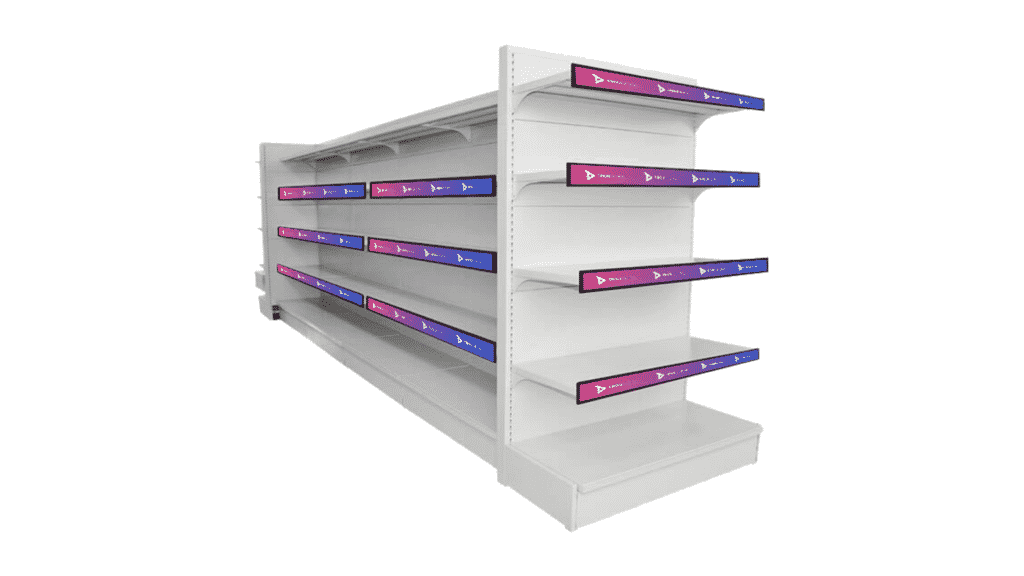
Types of digital shelf label displays
There are two main different types of digital shelf displays on the market. E-ink-based electronic shelf labels (also known as ESLs) and screen-based digital shelf label displays.
Let’s check them out.
Electronic shelf labels (ESLs)
Currently, the most common form of digital shelf label displays you might find in a retail store sit between paper-based labels and screen-based labels. These are known as electronic shelf labels. Electronic shelf labels (ESLs) are e-ink-based displays that allow retailers to display pricing on shelves.
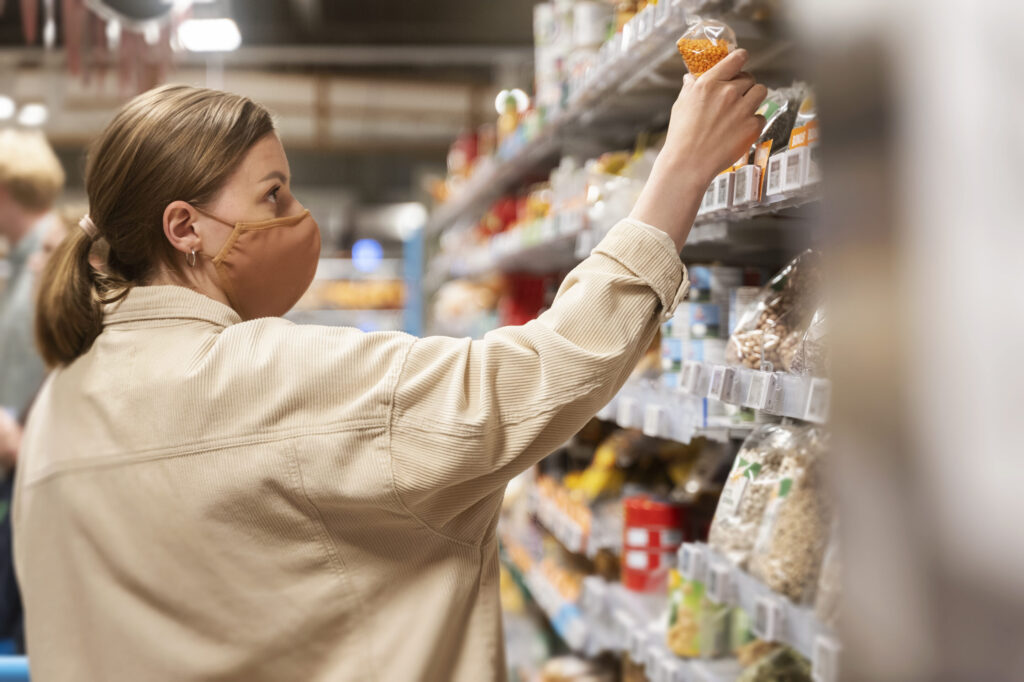
What is an e-ink display?
An e-ink display (electronic paper display) is the same type of screen you will find on a classic Kindle. E-ink displays utilise a thin, flexible film made of tiny capsules. These capsules contain black and white particles that are suspended in a clear fluid. When a charge is applied to the capsules, they move to the top or bottom of the fluid, creating an image or text on the surface of the film. The beauty of an e-ink display is that it can run without charge. A charge is only required when there is a change to what’s being displayed on the screen – pretty cool!
Electronic shelf labels utilising e-ink displays are easy to read in bright retail environments due to their high contrast ratio and use little power. Although highly limited, e-ink displays have developed to show a small range of colours.
Electronic shelf labels still have the capacity to automate product pricing. However, they lack the ability to properly grab the attention of customers and draw them to certain products and promotions.
Screen-based shelf labels
Screen-based shelf labels also called digital shelf label displays are exactly what we covered earlier in this guide. They are screens that have replaced paper-based shelf labels. With screens, retailers have greater flexibility when it comes to marketing, promotions, and pricing automation.
In the realm of physical digital shelf label displays, the difference comes down to the screen types. There are two main screen types LCD and LED
LCD screens
LCD displays use liquid crystal technology to display information. These screens provide users with high-quality images and can display full-colour graphics, making them ideal for product images and branding.
LED screens
LED displays use light-emitting diodes to display information on the shelf edge. These screens are bright and eye-catching, making them ideal for displaying promotional content.
The type of screen you use for your digital shelf edge labels with depend on your project’s location. For the best results, discuss your project goals with your digital signage provider.
The main draw to digital shelf edge labels over their e-ink-based electronic shelf label counterparts is their promotional capabilities. Screen-based digital labels are able to display dynamic, attention-grabbing promotional content which is providing retailers with huge sales uplifts.
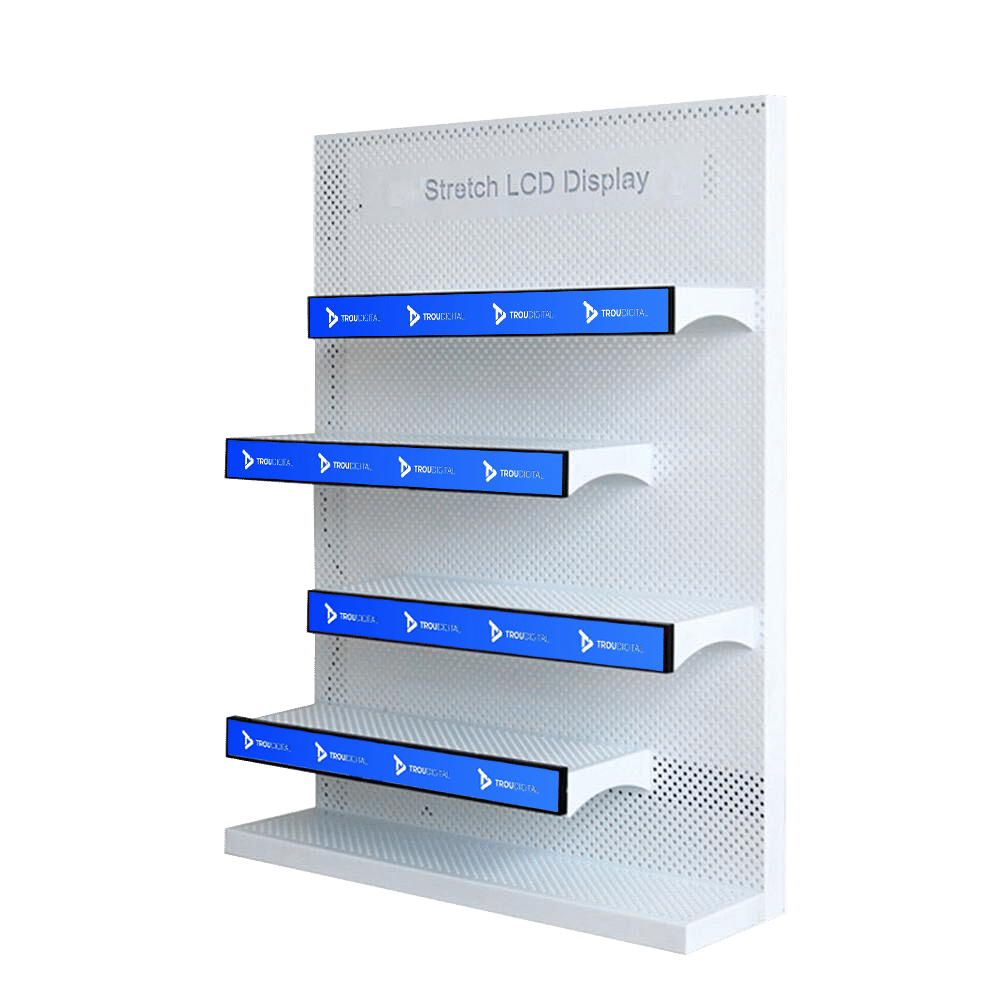
Introducing the eShelf – a new player in town
eShelves are another common name for digital shelf edge labels. eShelves have started taking the retail industry by storm and have quickly started turning the cogs in retail managers’ heads regarding how they can be used to boost sales and deliver a better customer experience.
You won’t see eShelves on every shelf you walk by. However, you may already notice some big players in the retail game already testing out this new technology. Whilst in its introductory stage, eShelves are getting a boost in attention as they turn customers’ heads who then come over to see what this new device is on the shelf.
During its introductory phase, eShelves are being used to showcase particular brands or promotions to help make them stand out. When the eShelves are in use, the brands on traditional paper displays begin to fall into the background and the brand with the eShelf is placed on centre stage. This is a great draw for new brands who wish to quickly make their mark in an already heavily saturated retail environment.
5 benefits of digital shelf edge labels
With new technologies come new and exciting benefits. Digital shelf labels are no exception. From grabbing attention and boosting sales to saving time here are 5 benefits of going digital with your shelves.
1. Digital shelves save retailers time (and money)
To the public it goes unnoticed, however, each year, retailers spend a considerable amount of time changing paper-based labels.
Tesco stocks around 40,000 products in its stores. Each and every one of these 40,000 products will require an individual label, with unique pricing, bar codes and other critical product information.
We could assume it takes 15 seconds to replace one paper-based label (not factoring in printing, travel to each label location, label design label disposal etc.). Therefore, changing all 40,000 labels one time would take 166 hours. Tesco operates across 2,764 stores in the UK with 1,966 being smaller convenience stores and 798 being larger stores. Being conservative with the number of products Tesco is currently selling, if they needed to change 20,000 product labels across their larger stores it would take 66,500 hours and would cost them £732,830.00 with an £11.02 hourly rate. And this is just for the larger stores changing half the product’s labels once.
66,600 hours equates to just over 8,312 8-hour shifts. Imagine what staff and their stores could achieve with that additional time. Creating attractive displays, providing better customer service, or completing more online deliveries.
Digital shelf edge labels are helping retailers get back this time. With automated pricing, shop floor employees don’t need to manually change pricing again. The screen-based labels connect to live pricing servers which will display the correct price on the shelf in real time.
2. A marketing opportunity like no other
It takes consumers just 3-5 seconds to notice a product on the shelves. During this time the consumer has often made up their mind about whether they are going to buy the product or not.
Retailers must do all they can within this 3-5 second period to ensure consumers notice the right products and also choose to buy them.
So what can they do?
Grab attention
Digital shelf edge displays are a great way to turn heads in the aisles and turn attention towards higher ticket items that satisfy customer needs and increase profitability.
Animations, brand promotional content and triggers can stop customers in their tracks and give them no option other than to stop and look. Brands can pay retailers to showcase their products on the shelf to put them in the spotlight like never before. Screen-led promotions could features that engage customers further, enticing purchases and increasing dwell time. For I.e. if a customer takes the product off the shelf, special content saying thank you, or “scan this QR code for a 10% discount” could play.
Increase dwell time
In addition to not being eye-catching, paper-based or e-ink labels are limited to displaying a small amount of information. There is nothing that helps keep the customer at the shelf to drive up dwell time and increase purchase probabilities.
Enter, digital shelf edge labels. With digital signage labels, retailers are able to activate an unlimited number of possibilities, ideas, and creative tactics to keep customers at the shelves and entice them to buy.
The most common method with screen-based shelves is video content. Retailers can play a brand’s animated videos and promotions to grab attention and get customers to watch. The animations could even include a discount countdown timer to entice customers to stay. Video content can be particularly effective if it’s an extension of a wider marketing campaign a customer is likely to have already seen or heard of.
Digital shelf labels are also great for showing more than just pricing. They can display detailed product information too. Whether it’s a more visual breakdown of what’s inside a protein bar vs competitors or even a how-to guide, this additional product information could be the difference between a customer choosing one product over the high ticket item.
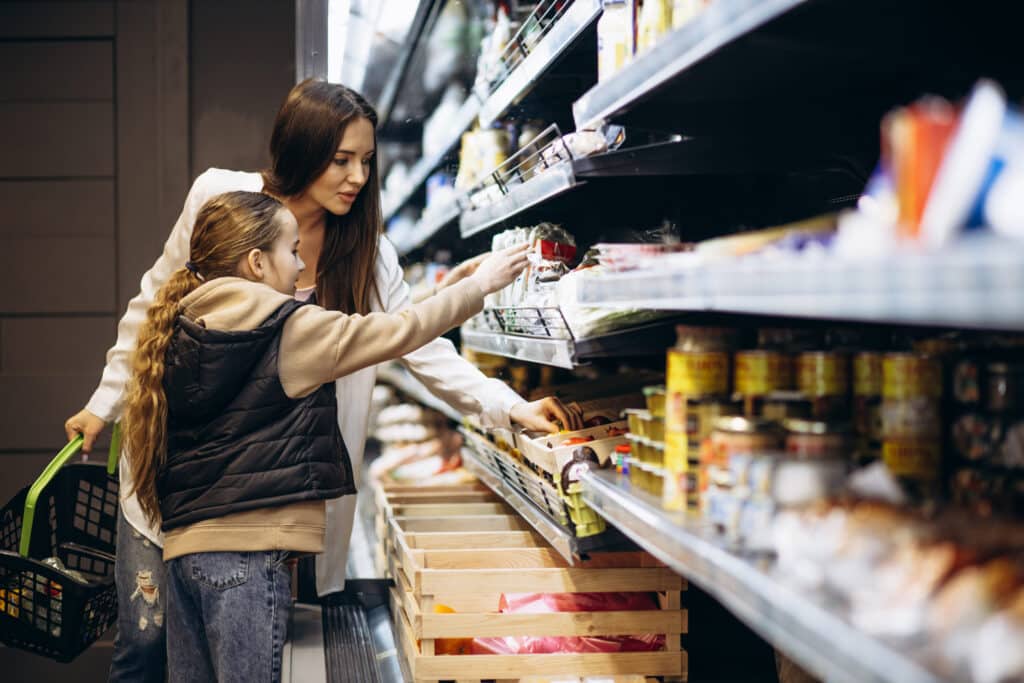
3. Increased compliance on the shelves
Showing the right information about a product is critical for all retailers. If retailers show the wrong pricing or incorrect product information it may mean they are uncompliant with current trading laws and standards, potentially leaving them liable to prosecution.
Displaying incorrect product information or pricing can harm consumer trust and push potential customers away. Not to mention how annoying it is when you pick up a product thinking you’ve got a great deal only to scan it at the till and find out it’s five times the price of the label… we’ve all been there.
In the UK (as of May 2022), the laws for retailers are that they must display:
- The price of products (in pounds and pence), including VAT where applicable.
- The unit price of a single item for loose products.
- Metric measures for unit pricing (expect some products like beer in pints).
So how can digital shelf edge labels keep retailers on the right side of the law?
Digital shelf labels are connected to a retailer’s central pricing server. This means that pricing matches what’s on the server to the penny. When the price changes on the server, it is updated on the shelf in real time – there’s no need to contact individual stores to change the price physically.
It’s worth noting that this goes for any product information too. For example, if a mistake has been made and the labels for a pack of rolls say that they are gluten-free, a central user can simply make the change from a central dashboard – avoiding the panic of raising the alarm for stores across the country.
4. Better for our planet
The ever-changing nature of supermarkets and retail shelves results in a huge disposal of paper-based labels. Each year an astronomical amount of labels will go to waste. When a price changes, a product develops, or the shelf location changes the label is rendered useless and disposed of.
If we re-visit our Tesco label example from earlier with the reduced 20,000 potential products in a store each needing individual labels, we can begin to visualise the impact paper-based labels are having on our planet. Let’s say each product needs a new label once a month, that’s 191,520,000 label changes per year just for the larger 798 stores – not including emergency changes, seasonal promotions etc.
With a digital solution, labels only need to be installed once and can be updated an unlimited number of times with no effect on the environment, helping retailers move closer to their net zero goals.
5. Brand sponsorship opportunities
Earlier we touched on how digital shelf displays are a great opportunity for retailers to showcase brands and generate sponsors. But what does this mean for retailers and how can sponsors help?
Retailers use something called ‘shelf positioning pricing’ or ‘shelf pricing strategy’ to offer brands the chance to pay different amounts to position themselves on different areas of the shelf. The eye level of the shelf is typically the most expensive segment of the shelves.
Digital shelf edge labels give retailers an additional opportunity and an opportunity for a larger package to offer brands. Brands are going to want the best chance of being seen on the highly saturated supermarket shelves and will pay a premium to increase their in-store visibility.
By charging more, retailers will have more resources to hand allowing them to improve the store and invest further in the customer experience. In terms of the brands buying the sponsorship opportunities, they will be happy to see a significant uplift in sales vs their competitors.
How do digital shelf edge labels work?
eShelf displays work in the same way as your other digital signage displays. However, these dynamic digital labels have the added functionality of live pricing and planogram software.
Here’s our handy diagram breaking down the key components of a digital shelf edge label project:
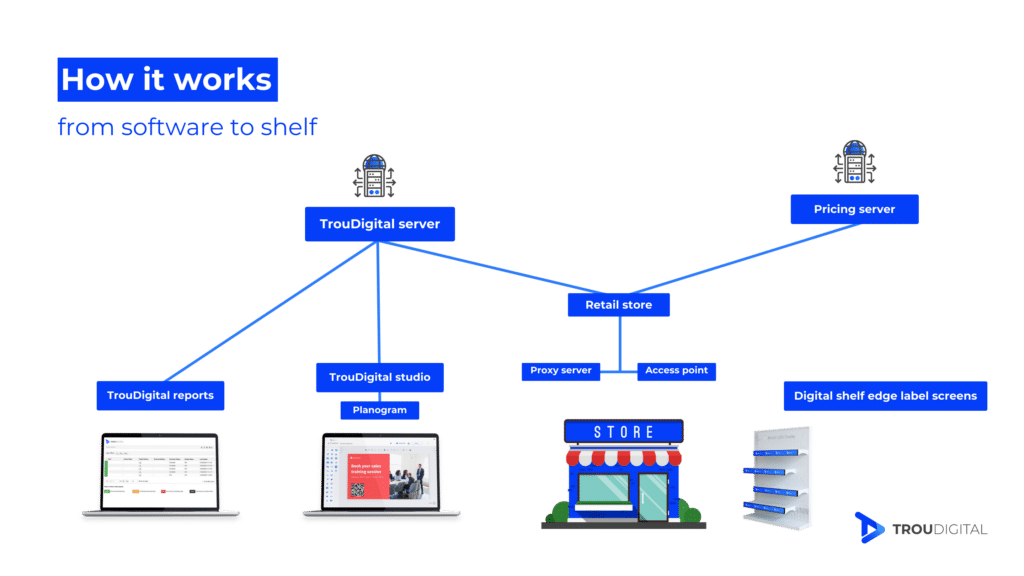
And here’s what each part does:
Shelf edge label display screens
The screens themselves bring your digital shelf labels to life. Once designed and set up you will be able to use digital signage software to deploy your promotions to the label screens. The digital signage software will be connected to your pricing servers, automatically updating pricing as and when required.
You’ll need to select the right screen depending on your project goals, shelf size, and retail environment. This includes the size of the screens, brightness, and durability.
Top features to look out for when buying shelf edge label display screen:
- A modern and slim design (to keep your store looking its best)
- Lightweight and easy to install (to get your project up and running ASAP)
- An anti-glare screen (to keep content visible in direct light)
- A low operating temperature (to save power and keep products safe)
- Solid metal enclosure (for durability)
- A high-brightness display panel (500-1000 nits will be suitable for most internal retail deployments)
- Built-in media player (for a smaller footprint and deploying the latest content changes to your labels)
- WiFi connectivity (to connect to software)
- High resolution of 1080p to 4K (to keep your content looking beautiful)
To get the best answer we recommend you speak to a digital signage expert who will point you in the right direction.
TrouDigital studio
The TrouDigital studio is digital signage software that allows you to fully manage your eShelves. From label creation and digital label management to deploying label updates nationwide, the TrouDigital studio allows you to take control of your shelves remotely from one device.
Choosing the right digital signage software is a critical component of a successful shelf-edge display project. Your software will help you manage a large network of digital shelf displays in addition to your other digital signage. For large deployments, it is crucial that you use digital signage software with features that allow you to easily manage large networks of screens, trigger, and schedule content.
Learn more about digital signage software.
Planogram
What is a planogram?
Simply put, it’s software that shows you a layout of your store’s shelves and sections, along with your inventory of products. With planogram software, you can set the order of how your shelves and sections will look, and exactly where each product will be placed on each shelf.
TrouDigital planogram
Planogram software should be easy to use, and the TrouDigital planogram system is no exception – it’s a drag-and-drop interface.
The planogram system becomes a powerful tool for retailers when integrated with a digital signage CMS like the TrouDigital platform. This integration allows retailers to set softlabels over digital shelf edge displays, price checker kiosks, and other screens that are integrated within the planogram software.
Any changes retailers make within the planogram software are instantly reflected on the eShelf displays in that store’s section. There is no need to make changes elsewhere.
Using your own planogram software?
The TrouDigital digital signage Studio can be integrated with the planogram software you already have. This means you can manage your eShelves showing soft labels with our CMS and integrate them with your planogram system.
TrouDigital reports
TrouDigital reporting gives you retailer full visibility on what’s playing on your shelves. It’s a great feature to show proof-of-play reports to sponsors and brands.
TrouDigital reports also give you peace of mind with visibility on what content is currently playing on your shelves and when they were last updated.
TrouDigital servers
Securely store your content ready to deploy to your screens.
Retail store
The store where the digital shelf edge labels will be deployed.
Proxy server
Proxy servers are used to provide secure and restricted internet access for your digital shelf edge labels.
Access point
Access points enable wireless communication between eShelves and the internet, allowing for remote content updates.
Pricing server
A pricing server integrates with the retailer’s backend systems to automatically update the pricing information on the screens based on the latest data. The pricing server can also manage promotional information, such as discounts and special offers, based on predefined rules and schedules.
The TrouDigital platform will content to the pricing server to pull in the latest pricing updates and display them as soft labels on relevant screens.
Best practices for digital shelf labels
Here are 5 best practices to help you optimise your digital shelf edge labels.
1. Placement is key
The placement of digital shelf edge displays is going to be crucial to their effectiveness. Proper placement can help to maximise visibility and customer engagement. On the other hand, poor placement can lead to low visibility and low engagement.
To determine the best placement for your digital shelf edge displays, consider the following factors:
Eye level
As mentioned previously, eye-level placement is considered the most prominent and visible area of the shelf. Products placed at eye-level tend to sell better than those placed on lower or higher areas of the shelves. This runs true even if the products are of similar quality and price.
Consider placing your eShelf displays at eye level to dive visibility and sales for the most popular or highest-margin products.
End caps
End caps are the displays located at the ends of the aisles. They are a prime location for promotions and can help to increase the visibility and awareness of certain products.
Consider using digital shelf edge displays on end caps to promote special offers, new products, or seasonal items.
Complementary products
Consider using digital shelf edge displays for complementary products next to each other. For example, if you sell coffee, consider placing digital shelf edge displays for biscuits next to the coffee displays. This can help to increase sales of both products and provide a better customer experience.
Convenience
Place digital shelf edge displays in convenient locations for customers. For example, if you sell cold beverages, consider placing digital shelf edge displays near the refrigerated section to make it easy for customers to find the products they’re looking for.
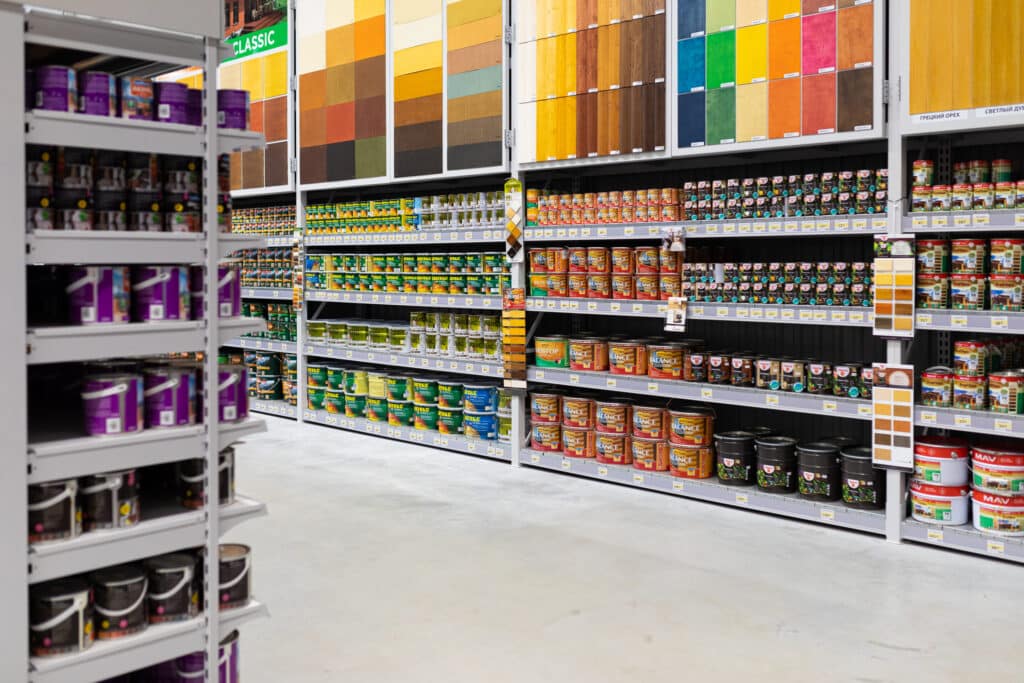
2. Monitor the performance of digital shelf displays
Regularly track sales data and customer engagement metrics to evaluate the effectiveness of your digital shelf edge displays. By analysing this data, you can make informed decisions about future content and placement to optimise their effectiveness, increase sales, and provide a better customer experience.
Keep an eye on your most important metrics with a live data TV dashboard.
3. Create engaging content
To capture customers’ attention and drive sales, it’s important to use engaging and visually appealing content on your digital shelf edge labels. This can include high-quality product images, videos, and animations.
Here are some of our top tips for creating engaging content to turn heads and boost sales:
Use high-quality images
90% of online buyers say that product image quality is the most important factor in their purchase. Could this translate to brick and mortar?
Use high-quality images of your products to showcase their features and benefits. Make sure the images are of a high resolution and accurately represent the products you sell.
Incorporate videos and animations
Use videos and animations to demonstrate how your products work or to showcase their features and benefits. This can be especially effective for products that are difficult to describe or demonstrate with images alone.
Keep it simple
Avoid cluttering your digital shelf edge displays with too much information. Instead, focus on the most important information, such as the product name, price, and key features.
Use eye-catching colours
Use bright, eye-catching colours to draw attention to your digital shelf edge labels. Make sure the colours are consistent with your branding and visually appealing to customers.
Highlight promotions
Use your digital shelf edge displays to promote special offers, discounts, or limited-time deals. This can help to increase sales and create a sense of urgency among customers.
4. Think customer-first and provide value
In addition to displaying product information, your digital shelf edge displays should provide additional value to customers. By providing valuable content, you can build trust with customers, increase engagement, and drive sales.
Here are some ways you can provide value to customers through your digital shelf edge displays:
Product Reviews
Consider displaying product reviews on your digital shelf edge labels. This can help customers make more informed purchase decisions and increase their trust in your products.
Nutritional Information
Displaying nutritional information on your digital shelf edge labels can help customers make healthier choices and provide a more transparent shopping experience.
Ingredient Lists
Displaying ingredient lists can help customers with allergies or dietary restrictions make informed purchase decisions.
Recipes
Consider using your digital shelf edge displays to provide recipe ideas or pairing suggestions. This can help to increase sales and provide a more engaging shopping experience for customers.
5. Digital signage triggers
Digital signage triggers allow you to automatically change the content displayed on your digital shelf edge labels based on external factors, such as the weather or time of day. By using these triggers, you can provide more relevant and engaging content to customers, and increase the effectiveness of your displays.
Here are some best practices for utilising digital signage triggers on your digital shelf edge displays:
Identify relevant triggers
Identify relevant triggers that are likely to impact customer behaviour, such as weather or time of day. For example, if it’s raining outside, you may want to display content related to rainy-day products, such as umbrellas or raincoats.
Customise content
Customise the content displayed on your digital shelf edge labels based on the trigger. For example, if the weather is hot, you may want to promote products that are refreshing and cool, such as cold drinks or ice cream.
Test and optimise
Continuously test and optimise your digital signage triggers to ensure that they are effective. This can involve analysing sales data and customer engagement metrics to determine which triggers are most effective at driving sales.
Don’t overdo it
Avoid overusing digital signage triggers, as this can lead to customer fatigue and reduce the effectiveness of your displays. Instead, use them strategically to provide relevant and engaging content to customers.
Part of a wider digital signage retail experience
In addition to digital shelf edge labels, retailers can use a variety of other digital displays to enhance the in-store shopping experience. Digital signage displays, for example, can be used to display promotions, advertisements, and informational content throughout the store.
Digital wayfinding is another type of digital signage that can be used in retail environments. These displays provide customers with information about store layouts and product locations, making it easier for them to navigate the store and find what they’re looking for.
Interactive displays are also becoming increasingly popular in retail environments. These displays allow customers to interact with products in a hands-on way, providing them with a more immersive shopping experience. For example, retailers can use interactive displays to allow customers to try on clothing virtually or to see how furniture would look in their homes.
By using a combination of digital shelf labels, digital signage displays, wayfinding displays, and interactive displays, retailers can create a more engaging and interactive shopping experience for customers. This can help to increase customer satisfaction, boost brand awareness, and drive sales.
Ultimately, digital signage in retail environments is all about creating a more seamless and immersive shopping experience for customers. By using a variety of different digital displays throughout the store, retailers can provide customers with the information and experiences they need to make informed purchase decisions. This, in turn, can lead to increased customer loyalty and improved store performance.
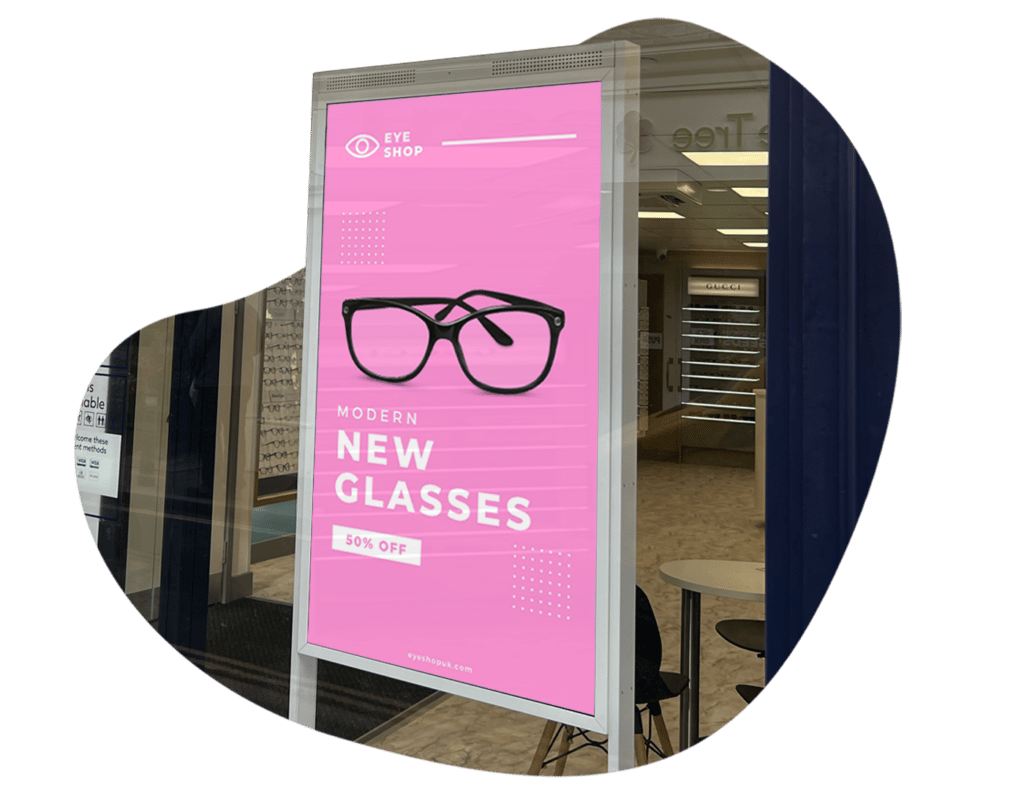
Final note
Digital shelf edge labels are an effective way for retailers to provide customers with engaging and informative shopping experiences that drive sales and improve customer satisfaction. By combining digital shelf displays with other types of digital signage and following best practices, retailers can create a seamless and immersive shopping experience that enhances customer loyalty and store performance.
Thanks so software integrations, not only do eShelves become a great visual selling tool, they are also helping retailers save valuable time and resources each day.
In short, digital shelf edge labels and other types of digital signage have the potential to revolutionise the retail industry and enhance the customer experience.
To Find out more about how digital shelf edge labels can transform your retail experience, speak to our experts:
